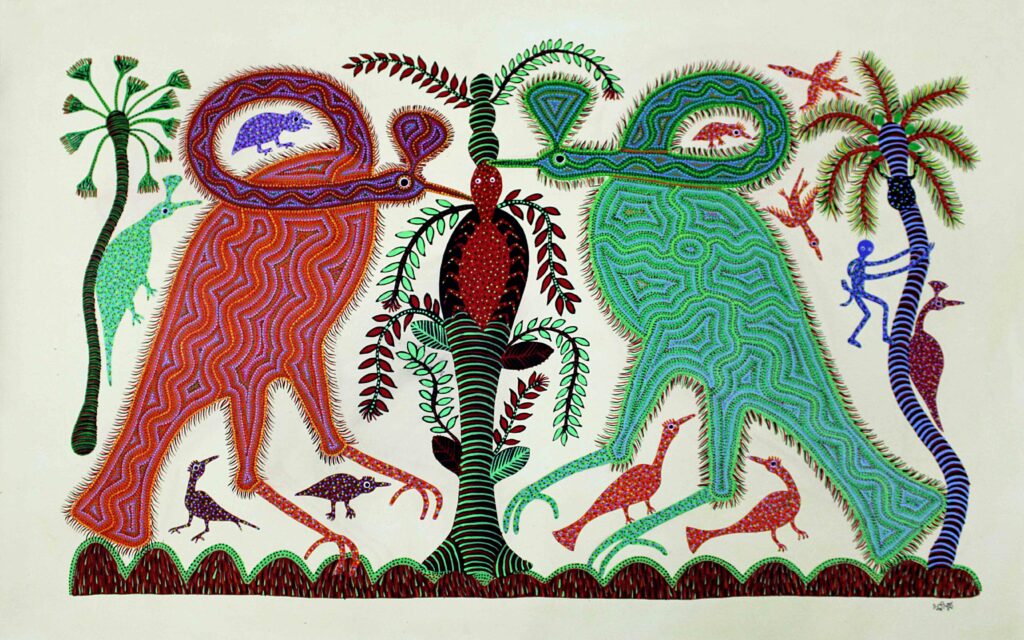By Team Mojarto
India is a land of colours and traditions. Our culture is our pride, self-esteem and identity. Similarly, some aspects of our society are deeply rooted in the traditions of our culture. One such aspect is folk art, which is an expression of a unique cultural essence and aesthetics. Indian folk art is vast, diverse and distinct. It is distinct from place to place, tribe to tribe and practice to practice.
However, over the century, Indian folk art has gone through several changes. Some have adapted to the new techniques, mediums and materials, while others remain untouched by the external factors. The themes and motifs in these art forms have undergone tremendous changes and have adapted to contemporary ideas, issues and thoughts. Folk arts like Madhubani, Gond and Warli paintings still stand majestically without succumbing to the pride of Peppa Pigs and digital punks.
Here are some of the most popular and sought after folk arts today. Explore through the pages of Mojarto to decorate your walls with an eclectic manifestation of Indian culture. Fill your rooms with a sense of antiquity, elegance and beauty through these folk artworks. The art forms, while steeped in tradition, are gradually evolving and incorporating contemporary elements! These artworks of devotion and happiness, created with utmost joy by artists invoke joyous feelings and positive vibes.
Rich in Ritual Content

The Ramayana has many beautiful heartwarming episodes that lend themselves wonderfully well to artistic inclinations. This beautiful and colourful Madhubani painting shows the return of Lord Rama and Lakshman to Ayodhya after the vanvasa (the exile). Every inch of this acrylic and ink canvas is covered with design. The little touches like the bird viewing with joy, the blooming flowers and the design of their ornate jewellery are what make it so appealing.
Madhubani painting is a folk art form that originated in the Mithila region and uses complex geometrical patterns. These paintings are rich in ritual content and the colours are mostly derived from plants and other natural sources. The paintings are created using objects found commonly around them like twigs, matchsticks and even fingers.
Inspiration from the Simple Things
Bhil art is a traditional art form that originated in Madhya Pradesh. Intricate art was created on the clay walls using neem sticks and other twigs. Natural dyes would be made using materials such as turmeric, flour, vegetables, leaves and oil. This work is by Bhuri Bhai, an internationally renowned practitioner of Bhil art. She derives her inspiration from the simple things she saw around her in her rural life. The colourful dots and lines used to create the bird stand in sharp contrast to the dark colouring of the images of a man and trees.
Tales of Srinathji

Pichwai art was created to narrate the various tales of Krishna to the masses. This art form was created by a community of Nadthwara artists and passed down from generation to generation. This work has been created with natural stone colour on cloth and depicts cows which are associated with Lord Krishna, who was a cow lover. The floral border gives the work a decorative look. The figurative style is distinct and would look great on any wall.
Intricate Lines and Dots

Gond tribes are one of the largest tribal communities in the country found mostly in Madhya Pradesh and Andhra Pradesh. They use this art form to ward off evil and welcome goodness. Today, the art is popular among artists who thrive to preserve and continue the culture and aesthetics of the art and the tribe. Gond art is characterised by the use of intricate, painstakingly made details and dots. This art is glorified for its vibrant colours.
